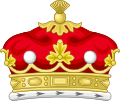| Marquessate of Tweeddale | |
|---|---|
 Arms: Quarterly: 1st & 4th, Argent, three Escutcheons Gules (Hay); 2nd, Gules, three Bars Ermine (Gifford); 3rd, Azure, three Cinquefoils Argent (Fraser). Crest: A Goat's Head erased Argent, armed Or. Supporters: On either side a Buck proper, attired and unguled Or, each gorged with a Collar Azure, charged with three Cinquefoils Argent. | |
| Creation date | 17 December 1694 |
| Created by | Mary II & William II |
| Peerage | Peerage of Scotland |
| First holder | John Hay, 1st Marquess of Tweeddale |
| Present holder | Charles David Montagu Hay, 14th Marquess of Tweeddale |
| Heir presumptive | Lord Alistair Hay, Master of Tweeddale |
| Remainder to | The 1st Marquess' heirs male whatsoever |
| Subsidiary titles |
|
| Status | Extant |
| Former seat(s) | Yester House |
| Motto | SPAIR NOUGHT |
Marquess of Tweeddale (sometimes spelled Tweedale) is a title of the Peerage of Scotland, created in 1694 for the 2nd Earl of Tweeddale. Lord Tweeddale holds the subsidiary titles of Earl of Tweeddale (created 1646), Earl of Gifford (1694), Viscount of Walden (1694), Lord Hay of Yester (1488), and Baron Tweeddale, of Yester in the County of Haddington (1881), [1] all but the last in the Peerage of Scotland. [2] As Baron Tweeddale in the Peerage of the United Kingdom, Lord Tweeddale sat between 1881 and 1963 in the House of Lords. The Marquess's eldest son uses Viscount Walden as a courtesy title.
Contents
- Lords Hay of Yester (1488)
- Earls of Tweeddale (1646)
- Marquesses of Tweeddale (1694)
- Present peer
- Coat of Arms
- Family tree and succession
- Notes
- See also
- References
- Further reading
- External links
Lord Tweeddale also holds the title of Hereditary Chamberlain of Dunfermline. [2]
The family seat was Yester House, near Gifford, East Lothian, Scotland.



